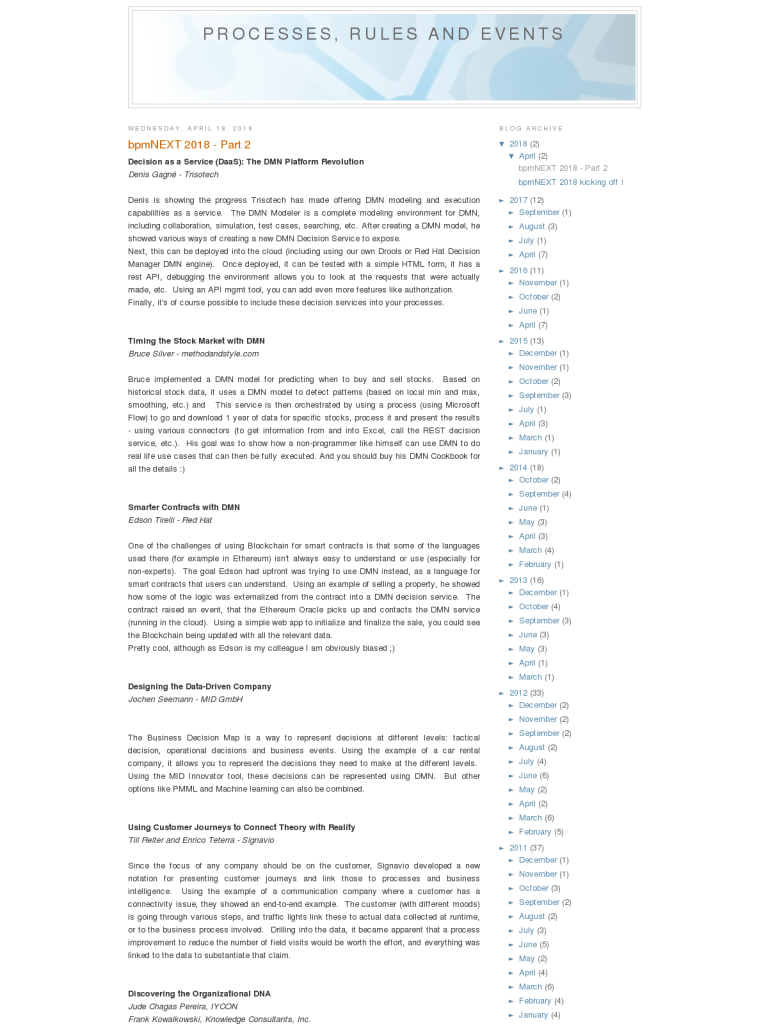Decision as a Service (DaaS): The DMN Platform Revolution
Denis Gagné – Trisotech
Denis is showing the progress Trisotech has made offering DMN modeling and execution capabilities as a service. The DMN Modeler is a complete modeling environment for DMN, including collaboration, simulation, test cases, searching, etc. After creating a DMN model, he showed various ways of creating a new DMN Decision Service to expose.
Next, this can be deployed into the cloud (including using our own Drools or Red Hat Decision Manager DMN engine). Once deployed, it can be tested with a simple HTML form, it has a rest API, debugging the environment allows you to look at the requests that were actually made, etc. Using an API mgmt tool, you can add even more features like authorization.
Finally, it’s of course possible to include these decision services into your processes.
Timing the Stock Market with DMN
Bruce Silver – methodandstyle.com
Bruce implemented a DMN model for predicting when to buy and sell stocks. Based on historical stock data, it uses a DMN model to detect patterns (based on local min and max, smoothing, etc.) and This service is then orchestrated by using a process (using Microsoft Flow) to go and download 1 year of data for specific stocks, process it and present the results – using various connectors (to get information from and into Excel, call the REST decision service, etc.). His goal was to show how a non-programmer like himself can use DMN to do real life use cases that can then be fully executed. And you should buy his DMN Cookbook for all the details 🙂
Smarter Contracts with DMN
Edson Tirelli – Red Hat
One of the challenges of using Blockchain for smart contracts is that some of the languages used there (for example in Ethereum) isn’t always easy to understand or use (especially for non-experts). The goal Edson had upfront was trying to use DMN instead, as a language for smart contracts that users can understand. Using an example of selling a property, he showed how some of the logic was externalized from the contract into a DMN decision service. The contract raised an event, that the Ethereum Oracle picks up and contacts the DMN service (running in the cloud). Using a simple web app to initialize and finalize the sale, you could see the Blockchain being updated with all the relevant data.
Pretty cool, although as Edson is my colleague I am obviously biased 😉
Designing the Data-Driven CompanyJochen Seemann – MID GmbH
The Business Decision Map is a way to represent decisions at different levels: tactical decision, operational decisions and business events. Using the example of a car rental company, it allows you to represent the decisions they need to make at the different levels. Using the MID Innovator tool, these decisions can be represented using DMN. But other options like PMML and Machine learning can also be combined.
Using Customer Journeys to Connect Theory with Reality
Till Reiter and Enrico Teterra – Signavio
Since the focus of any company should be on the customer, Signavio developed a new notation for presenting customer journeys and link those to processes and business intelligence. Using the example of a communication company where a customer has a connectivity issue, they showed an end-to-end example. The customer (with different moods) is going through various steps, and traffic lights link these to actual data collected at runtime, or to the business process involved. Drilling into the data, it became apparent that a process improvement to reduce the number of field visits would be worth the effort, and everything was linked to the data to substantiate that claim.
Discovering the Organizational DNA
Jude Chagas Pereira, IYCON
Frank Kowalkowski, Knowledge Consultants, Inc.
Afterspyre offers various kind of analytics to help organizations make the right decisions. By modeling your organizational DNA (like objectives, technology solutions, datacenters, etc.), the tool can then find any relationships between all these (for example which datacenter is running which objectives). Other options include sentiment analysis (based on feedback from customers), affinity matrices (checking how well different thinks go together), ranking (comparing different options with each other), etc.








